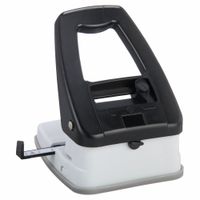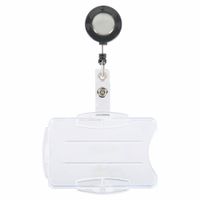Call +(254) 703 030 000 / 751 483 999 / 721 704 777
.....Read More
Frequently Asked Questions
What are the best ID card printers for creating employee badges?
The best ID card printers for creating employee badges are those that offer a balance of quality, speed, and cost-effectiveness. Here are some top options:
1. **Fargo HDP5000**: Known for its high-definition printing, the Fargo HDP5000 uses retransfer technology to produce sharp, vibrant images. It's ideal for organizations needing high-quality, durable cards. It supports various encoding options, making it versatile for different security needs.
2. **Zebra ZC300**: This printer is compact and user-friendly, perfect for businesses with limited space. It offers edge-to-edge printing and supports both single and dual-sided printing. The ZC300 is known for its speed and reliability, making it suitable for medium to large organizations.
3. **Evolis Primacy**: The Evolis Primacy is a fast, efficient printer that can handle large volumes, making it ideal for larger companies. It offers high-resolution printing and can encode magnetic stripes and smart cards. Its modular design allows for easy upgrades.
4. **Magicard Enduro3E**: This printer is cost-effective and offers good print quality. It includes Magicard’s HoloKote security feature, which adds a watermark to cards at no extra cost. It's suitable for small to medium-sized businesses looking for a balance between cost and functionality.
5. **Datacard SD360**: Known for its reliability and ease of use, the Datacard SD360 offers dual-sided printing and a variety of encoding options. It’s a great choice for organizations that need to produce a moderate volume of cards with secure features.
When choosing an ID card printer, consider factors like print volume, card durability, security features, and budget. Each of these printers offers unique features that cater to different organizational needs, ensuring high-quality employee badges.
How do I choose the right ID card printer for my organization?
To choose the right ID card printer for your organization, consider the following factors:
1. **Volume and Speed**: Determine the number of cards you need to print daily. For high-volume needs, opt for a high-speed printer with a large input/output hopper.
2. **Print Quality**: Assess the quality of print required. For detailed images and vibrant colors, choose a printer with high DPI (dots per inch).
3. **Card Type**: Decide if you need single-sided or dual-sided printing. Dual-sided printers are ideal for cards requiring information on both sides.
4. **Encoding Options**: If your cards need magnetic stripes, smart chips, or RFID, select a printer with encoding capabilities.
5. **Durability and Security**: For long-lasting cards, consider printers with lamination options. For security, look for features like holographic overlays.
6. **Connectivity**: Ensure the printer supports your network setup, whether USB, Ethernet, or wireless.
7. **Ease of Use**: Choose a printer with user-friendly software and easy maintenance features, such as simple ribbon replacement.
8. **Budget**: Balance your needs with your budget. Consider not just the initial cost but also the cost of consumables like ribbons and cards.
9. **Brand and Support**: Opt for reputable brands known for reliability and good customer support. Check warranty and service options.
10. **Scalability**: Consider future needs. Choose a printer that can scale with your organization’s growth.
By evaluating these factors, you can select an ID card printer that meets your organization’s specific requirements efficiently and cost-effectively.
What are the differences between direct-to-card and retransfer ID card printers?
Direct-to-card (DTC) and retransfer ID card printers differ primarily in their printing processes and the quality of the output.
1. **Printing Process**:
- **Direct-to-Card (DTC)**: This method involves printing directly onto the surface of the card. The printer uses a thermal printhead to transfer ink from a ribbon onto the card. This process is quick and cost-effective but may leave a small white border around the edges.
- **Retransfer**: This method prints the image onto a clear film first, which is then fused onto the card. This allows for edge-to-edge printing without borders and can accommodate uneven card surfaces.
2. **Print Quality**:
- **DTC**: Generally produces good quality images but may not be as vibrant or detailed as retransfer prints. The direct contact with the card can lead to imperfections if the card surface is not perfectly smooth.
- **Retransfer**: Offers superior image quality with high resolution and vibrant colors. The retransfer process can handle complex images and fine details better than DTC.
3. **Durability**:
- **DTC**: Cards printed with DTC may be more susceptible to wear and fading over time, especially if exposed to harsh conditions.
- **Retransfer**: The additional film layer provides extra protection, making the cards more durable and resistant to scratches and fading.
4. **Card Compatibility**:
- **DTC**: Best suited for standard PVC cards. It may not work well with cards that have embedded electronics or uneven surfaces.
- **Retransfer**: Can print on a wider variety of card materials, including those with embedded chips or antennas.
5. **Cost**:
- **DTC**: Generally less expensive upfront and in terms of consumables.
- **Retransfer**: Higher initial cost and consumables, but the enhanced quality and durability can justify the expense for certain applications.
How often should I replace the printer ribbon in an ID card printer?
The frequency of replacing the printer ribbon in an ID card printer depends on several factors, including the type of printer, the volume of printing, and the specific ribbon used. Generally, printer ribbons are designed to last for a specific number of prints, which is usually indicated by the manufacturer. For example, a standard YMCKO ribbon might be rated for 200 to 300 prints.
If you are printing at a high volume, you may need to replace the ribbon more frequently, possibly every few days or weeks. For lower volume printing, the ribbon might last several months. It's important to monitor the print quality; faded colors or incomplete images can indicate that the ribbon is nearing the end of its life.
Additionally, some printers have built-in alerts or software that notifies you when the ribbon is low or needs replacement. Always ensure you have spare ribbons on hand to avoid interruptions. Regular maintenance and following the manufacturer's guidelines can also help optimize ribbon usage and extend its lifespan.
What are the benefits of using laminates on ID cards?
Laminates on ID cards offer several benefits that enhance the durability, security, and appearance of the cards. Firstly, laminates provide a protective layer that shields the card from physical damage such as scratches, moisture, and general wear and tear. This extends the lifespan of the ID card, ensuring it remains functional and legible over time.
Secondly, laminates enhance security by making it more difficult to alter or counterfeit the ID card. Many laminates can incorporate security features such as holograms, UV printing, or microtext, which are challenging to replicate. This helps in verifying the authenticity of the card and prevents unauthorized duplication.
Additionally, laminates improve the visual appeal of ID cards. They can enhance the colors and clarity of printed information, making text and images more vibrant and easier to read. This is particularly important for ID cards that require quick visual verification.
Laminates also offer customization options. Organizations can choose from various finishes, such as matte or glossy, to suit their branding or functional needs. Some laminates can be designed to include specific logos or designs, further personalizing the ID cards.
Moreover, laminates can provide a cost-effective solution for ID card maintenance. By protecting the card from damage, laminates reduce the need for frequent replacements, saving organizations money in the long run.
Finally, laminates contribute to environmental sustainability by reducing waste. Since laminated cards last longer, fewer resources are needed for producing replacements, which can help in minimizing the environmental impact associated with ID card production.
In summary, laminates on ID cards offer enhanced durability, security, visual appeal, customization, cost-effectiveness, and environmental benefits, making them a valuable addition to any ID card system.
How do I encode access control information onto ID cards?
To encode access control information onto ID cards, follow these steps:
1. **Select Card Type**: Choose the appropriate card type based on your needs, such as magnetic stripe cards, smart cards, or RFID cards.
2. **Access Control System**: Ensure you have an access control system that supports card encoding. This system will manage user permissions and integrate with card readers.
3. **Card Encoding Software**: Use specialized software compatible with your access control system. This software will encode the necessary data onto the cards.
4. **Data Preparation**: Gather the required access control information, such as user ID, access levels, and expiration dates. Ensure data is organized and secure.
5. **Encoding Process**:
- **Magnetic Stripe Cards**: Use a magnetic stripe card encoder to write data onto the card's magnetic stripe. The data is usually encoded in three tracks, with Track 2 commonly used for access control.
- **Smart Cards**: Use a smart card encoder to write data onto the card's chip. This can include more complex data structures and encryption for enhanced security.
- **RFID Cards**: Use an RFID card encoder to program the card's chip with the necessary access information. RFID cards can be encoded with unique identifiers linked to user profiles in the access control system.
6. **Testing**: After encoding, test the cards with your access control readers to ensure they function correctly and grant the appropriate access.
7. **Distribution and Management**: Distribute the encoded cards to users and maintain a secure database of cardholder information. Regularly update and manage access permissions as needed.
8. **Security Measures**: Implement encryption and secure protocols to protect the data on the cards and during transmission between the card and readers. Regularly audit and update security measures to prevent unauthorized access.
What are the most durable materials for ID card blanks?
The most durable materials for ID card blanks include:
1. **Polyvinyl Chloride (PVC):** PVC is the most common material used for ID cards due to its affordability and ease of printing. It offers good durability for everyday use, making it suitable for standard ID cards.
2. **Composite PVC-PET:** This material combines PVC with polyethylene terephthalate (PET), enhancing durability and resistance to bending and cracking. It is ideal for cards that require a longer lifespan and are subject to frequent handling.
3. **Polycarbonate (PC):** Known for its exceptional durability, polycarbonate is highly resistant to impact, heat, and chemicals. It is often used for government-issued IDs and driver's licenses due to its longevity and security features, such as laser engraving.
4. **Teslin:** Teslin is a synthetic paper material that is highly durable and resistant to water, chemicals, and tearing. It is often used for laminated ID cards, providing a flexible yet robust option.
5. **PETG (Polyethylene Terephthalate Glycol):** PETG is a variant of PET that offers enhanced durability and environmental resistance. It is less brittle than standard PET and is often used for cards that require high durability and environmental friendliness.
6. **ABS (Acrylonitrile Butadiene Styrene):** ABS is a strong, impact-resistant plastic that is sometimes used for ID cards requiring extra toughness. It is less common but offers excellent durability.
7. **Metal:** For high-security applications, metal ID cards made from materials like stainless steel or aluminum provide unmatched durability and resistance to wear and tear. They are often used for access control in secure environments.
These materials are chosen based on the specific requirements of durability, security, and environmental conditions the ID cards will face.
How can I troubleshoot common issues with ID card printers?
To troubleshoot common issues with ID card printers, follow these steps:
1. **Check Power and Connections**: Ensure the printer is plugged in and turned on. Verify all cables are securely connected.
2. **Driver and Software**: Confirm that the printer driver and software are correctly installed and updated. Reinstall if necessary.
3. **Printer Settings**: Check the printer settings in the software to ensure they match the card size and type you are using.
4. **Card and Ribbon Loading**: Ensure cards and ribbons are loaded correctly. Check for any jams or misalignments.
5. **Clean the Printer**: Regularly clean the printer using manufacturer-recommended cleaning kits to prevent dust and debris buildup.
6. **Error Messages**: Refer to the printer’s manual or online resources to interpret error codes or messages displayed.
7. **Test Print**: Run a test print to diagnose issues. Check for streaks, misprints, or color issues.
8. **Firmware Updates**: Ensure the printer’s firmware is up to date to avoid compatibility issues.
9. **Card Quality**: Use high-quality cards that are compatible with your printer to prevent jams and print errors.
10. **Environment**: Ensure the printer is in a suitable environment, free from extreme temperatures and humidity.
11. **Contact Support**: If issues persist, contact the manufacturer’s support for further assistance.
By systematically addressing these areas, you can resolve most common ID card printer issues.
What accessories are available for displaying and protecting ID badges?
Accessories for displaying and protecting ID badges include:
1. **Badge Holders**: These are clear or colored plastic sleeves that protect the badge from wear and tear. They come in various styles, such as vertical or horizontal orientation, and can be rigid or flexible.
2. **Lanyards**: Worn around the neck, lanyards are a popular choice for displaying ID badges. They come in different materials like polyester, nylon, or cotton and can be customized with logos or text.
3. **Badge Reels**: These retractable devices allow easy access to ID badges. They attach to clothing and have a retractable cord, making it convenient to swipe or show the badge without detaching it.
4. **Badge Clips**: Simple and effective, badge clips attach directly to clothing. They often feature a metal or plastic clip and a strap that loops through the badge holder.
5. **Badge Pins**: These are similar to clips but use a pin mechanism to attach the badge to clothing. They are less common due to the potential to damage fabric.
6. **Armband Holders**: Ideal for active environments, these holders strap around the arm, keeping the badge secure and visible without interfering with movement.
7. **Magnetic Badge Holders**: These use magnets to attach the badge to clothing, avoiding damage from pins or clips. They are suitable for lightweight badges.
8. **Badge Wallets**: Combining functionality with protection, badge wallets hold the ID badge along with other essentials like credit cards or cash.
9. **Badge Buddy**: An additional card that hangs behind the ID badge, providing extra information like job title or department for quick identification.
10. **Protective Covers**: These are additional layers that can be placed over the badge holder to protect against water, dust, or other environmental factors.
How do I maintain and clean an ID card printer to ensure optimal performance?
To maintain and clean an ID card printer for optimal performance, follow these steps:
1. **Regular Cleaning Schedule**: Establish a routine cleaning schedule based on the manufacturer's recommendations, typically after every 1,000 prints or when print quality declines.
2. **Use Manufacturer-Approved Cleaning Kits**: Always use cleaning kits and supplies recommended by the printer manufacturer to avoid damage.
3. **Clean the Printer Rollers**: Use a lint-free cloth or a cleaning card to remove dust and debris from the rollers. This prevents card jams and ensures smooth card feeding.
4. **Clean the Printhead**: Use a printhead cleaning pen or swab to gently clean the printhead. This prevents streaks and ensures clear printing.
5. **Clean the Card Path**: Run a cleaning card through the printer to remove dust and debris from the card path. This helps maintain print quality and prevents jams.
6. **Check and Clean the Ribbon**: Inspect the ribbon for wrinkles or debris. Clean the ribbon path with a lint-free cloth if necessary. Replace the ribbon if it shows signs of wear.
7. **Inspect and Clean the Card Hopper**: Remove any dust or debris from the card hopper to ensure smooth card feeding.
8. **Update Firmware and Drivers**: Regularly check for and install updates for the printer’s firmware and drivers to ensure optimal performance and compatibility.
9. **Store Supplies Properly**: Keep ribbons, cards, and cleaning supplies in a clean, dry environment to prevent contamination.
10. **Monitor Printer Environment**: Ensure the printer is in a dust-free, stable environment with controlled temperature and humidity to prevent damage and maintain performance.
By following these steps, you can ensure your ID card printer operates efficiently and produces high-quality prints consistently.




